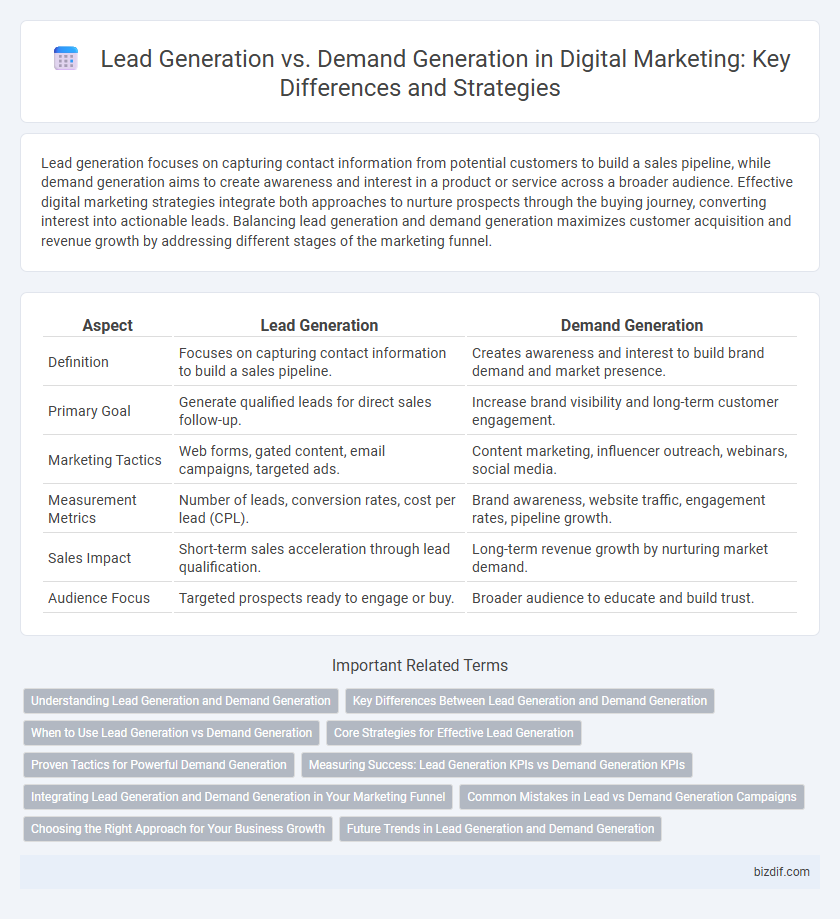Lead generation focuses on capturing contact information from potential customers to build a sales pipeline, while demand generation aims to create awareness and interest in a product or service across a broader audience. Effective digital marketing strategies integrate both approaches to nurture prospects through the buying journey, converting interest into actionable leads. Balancing lead generation and demand generation maximizes customer acquisition and revenue growth by addressing different stages of the marketing funnel.
Table of Comparison
| Aspect | Lead Generation | Demand Generation |
|---|---|---|
| Definition | Focuses on capturing contact information to build a sales pipeline. | Creates awareness and interest to build brand demand and market presence. |
| Primary Goal | Generate qualified leads for direct sales follow-up. | Increase brand visibility and long-term customer engagement. |
| Marketing Tactics | Web forms, gated content, email campaigns, targeted ads. | Content marketing, influencer outreach, webinars, social media. |
| Measurement Metrics | Number of leads, conversion rates, cost per lead (CPL). | Brand awareness, website traffic, engagement rates, pipeline growth. |
| Sales Impact | Short-term sales acceleration through lead qualification. | Long-term revenue growth by nurturing market demand. |
| Audience Focus | Targeted prospects ready to engage or buy. | Broader audience to educate and build trust. |
Understanding Lead Generation and Demand Generation
Lead generation focuses on capturing contact information from potential customers through targeted campaigns, landing pages, and call-to-actions to build a qualified sales pipeline. Demand generation aims to create awareness and interest in a brand or product by leveraging content marketing, social media, SEO, and experiential marketing to drive broader market engagement. Understanding the distinction between these strategies helps businesses align marketing efforts with sales goals and optimize customer acquisition processes.
Key Differences Between Lead Generation and Demand Generation
Lead generation focuses on capturing contact information from potential customers through targeted campaigns, while demand generation aims to create awareness and interest in a brand or product across a broader audience. Lead generation typically involves specific call-to-actions, such as form submissions or sign-ups, whereas demand generation uses content marketing, social media, and educational resources to nurture engagement and build brand credibility. The key difference lies in lead generation's emphasis on immediate conversions versus demand generation's strategic approach to long-term relationship building and market positioning.
When to Use Lead Generation vs Demand Generation
Use lead generation when the goal is to capture contact information from potential customers who are already interested and ready to engage, enabling direct follow-up and nurturing through personalized campaigns. Opt for demand generation to build broader market awareness and stimulate interest in a brand or product among a wider audience, driving long-term customer relationships and brand loyalty. Lead generation suits sales-ready prospects, while demand generation targets earlier stages of the buyer's journey to create initial interest.
Core Strategies for Effective Lead Generation
Core strategies for effective lead generation in digital marketing include targeted content marketing, personalized email campaigns, and optimized landing pages designed to capture visitor information. Leveraging data analytics to identify and segment ideal customer profiles enhances lead quality and conversion rates. Integrating multi-channel outreach, such as social media ads and retargeting, ensures sustained engagement and nurtures prospects through the sales funnel.
Proven Tactics for Powerful Demand Generation
Proven tactics for powerful demand generation include leveraging content marketing, targeted social media campaigns, and influencer partnerships to build brand awareness and stimulate interest. Employing data-driven strategies such as predictive analytics and account-based marketing enhances audience targeting and engagement. Optimizing landing pages and personalized email workflows further nurtures demand, leading to higher conversion rates and sustained growth.
Measuring Success: Lead Generation KPIs vs Demand Generation KPIs
Lead generation KPIs focus on metrics such as conversion rates, cost per lead (CPL), and lead quality scores to assess the effectiveness of capturing potential customer information. Demand generation KPIs emphasize brand awareness, website traffic, engagement rates, and marketing qualified leads (MQLs) to evaluate the influence on broader audience interest and demand creation. Measuring success in digital marketing requires aligning KPIs with campaign objectives to optimize resource allocation and maximize ROI.
Integrating Lead Generation and Demand Generation in Your Marketing Funnel
Integrating lead generation and demand generation within your marketing funnel enhances customer acquisition and brand awareness simultaneously by aligning targeted content with strategic nurturing tactics. Demand generation drives interest and engagement through broad campaigns, while lead generation captures qualified prospects by focusing on conversion points like gated content and personalized follow-ups. This cohesive approach maximizes funnel efficiency, ensuring consistent pipeline growth and higher return on investment in digital marketing efforts.
Common Mistakes in Lead vs Demand Generation Campaigns
Common mistakes in lead generation campaigns include overemphasizing quantity over quality, leading to unqualified prospects that waste sales resources. In demand generation, marketers often confuse awareness metrics with actual interest, resulting in high engagement but low conversion rates. Both campaign types suffer when targeting is too broad or messaging lacks alignment with customer pain points, reducing overall effectiveness.
Choosing the Right Approach for Your Business Growth
Lead generation targets capturing contact information from potential customers to build a sales pipeline, while demand generation focuses on increasing overall awareness and interest in your brand through content and engagement. Choosing the right approach depends on business goals: prioritize lead generation for direct sales acceleration and demand generation for long-term brand visibility and market education. Align your strategy with your sales cycle length, audience behavior, and budget to maximize growth and ROI.
Future Trends in Lead Generation and Demand Generation
Future trends in lead generation and demand generation emphasize AI-powered personalization and automation to optimize customer targeting and engagement. Predictive analytics and machine learning increasingly drive real-time data insights, enabling marketers to anticipate consumer behavior and tailor campaigns effectively. Integration of omnichannel strategies, including social media, email, and content marketing, enhances seamless lead nurturing and demand creation across diverse platforms.
Lead generation vs Demand generation Infographic

 bizdif.com
bizdif.com